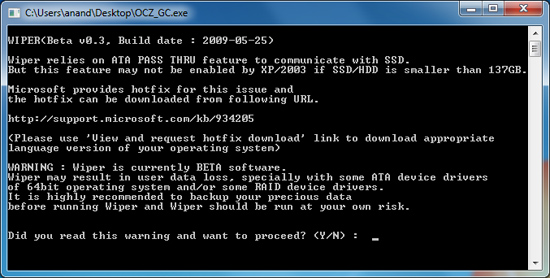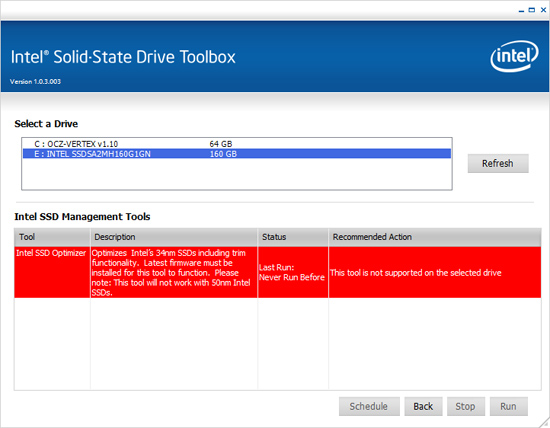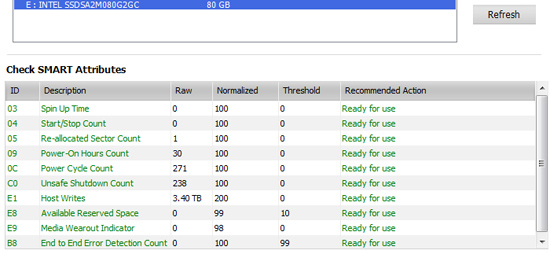The SSD Improv: Intel & Indilinx get TRIM, Kingston Brings Intel Down to $115
by Anand Lal Shimpi on November 17, 2009 7:00 PM EST- Posted in
- Storage
Wipe When You Can’t TRIM
There’s a major problem with TRIM today. The only Windows storage drivers to support it are written by Microsoft. The Intel Matrix Storage Manager (IMSM) driver will not pass the TRIM instruction to your SSD. This means you can't use anything but the drivers that ship with Windows 7. To make matters worse, if you enable non-member RAID on an Intel motherboard the default Windows 7 driver is an older version of IMSM so TRIM won't work there either - even if you don't have a RAID array created. Your best bet is to install Windows 7 with your I/O controller in AHCI mode (for Intel chipsets) and don't install any storage drivers. Intel is working on an updated IMSM that will pass the TRIM instruction to SSDs but it won't be ready for at least a couple of months.
TRIM won't work on a RAID array.
If you want to use IMSM or if you're using Windows XP or Vista, both of which do not support TRIM, there's another option. Earlier this year Indilinx released its Wiper Tool that performs a manual TRIM on their SSDs. It works by asking the OS for a list of the free space addresses on the partition and then sending the list with instructions to TRIM down to the SSD.

The Indilinx Wiper Tool
Today Intel introduces its own manual TRIM tool as a part of the SSD Toolbox:

On any Windows OS (XP, Vista or 7) regardless of what driver you have installed, Intel's SSD Toolbox will allow you to manually TRIM your drive. Intel calls it the SSD Optimizer, which of course only works on 34nm Intel SSDs (X25-M G1 owners are out of luck unfortunately).

The Intel SSD Optimizer lets you schedule the manual TRIM operation automatically
The SSD Toolbox also gives you access to SMART and drive health data, including telling you how many writes you've performed on your SSD, and what your current flash wear level is:

Running Intel's SSD Optimizer does work as advertised. I ran the PCMark HDD suite on a clean X25-M, once more on a drive that had been well used and once more after running the SSD Optimizer:
| PCMark Vantage HDD Score | Clean Run | Used Run | After SSD Optimizer |
| Intel X25-M G2 160GB | 35909 | 30354 | 34014 |
Intel's SSD Optimizer should be able to restore performance to about 95%+ of new, in this case it manages 94.7% - close enough.
Moving On: Forget About Invalid Data and Worry About Free Space
The existence of TRIM changes the way we test, something I alluded to in the SSD Relapse. Thankfully, we come prepared.
In previous articles we had to test SSDs in two conditions: new and used. The new state is just after a secure erase, the used state required us to write data to every user accessible portion of the drive first before benchmarking. The former resulted in great performance, the latter meant the SSD had to do a lot of juggling of existing data whenever it went to write. The second scenario no longer exists with TRIM. The act of formatting your drive or deleting files (and emptying the recycle bin) will TRIM invalid data.
Performance in a TRIM enabled system is now determined not by the number of invalid blocks on your SSD, but rather the amount of free space you have. I went into a deep explanation of the relationship between free space and the performance of some SSDs here.
TRIM will make sure that you don’t have to worry about your drive filling up with invalid data, but it doesn’t skirt the bigger issue: dynamic controllers see their performance improve with more free space.
My rule of thumb is to keep at least 20% free space on your drive, you can get by with less but performance tends to suffer. It doesn’t degrade by the same amount for all drives either. Some controllers are more opportunistic with free space (e.g. Intel), while others don’t seem to rely as much on free space for improved performance. Addressing performance degradation as drives fill up (with valid data) will be one of the next major advancements in SSD technology.










162 Comments
View All Comments
Anand Lal Shimpi - Monday, October 26, 2009 - link
Thanks guys :)Take care,
Anand
jimhsu - Monday, October 26, 2009 - link
Since I've been wondering about the free space issue, will there be a test where a drive is benchmarked vs. the amount of free space available? My guess is that the graph will be an exponential decay with the "noticeable" regime at 20% free space. Anyone cares to do this (say, at 90%, 80% ... close to zero free space)?Crittias - Monday, October 26, 2009 - link
So, without TRIM, is there anything else G1 owners can do? Can I manually wipe the drive and reinstall my OS every few months? If so, should I?mataichi - Monday, October 26, 2009 - link
I have the G1 and in Anand's previous SSD Anthology article he tells how to get back to 100% performance using HDDERASE.http://www.anandtech.com/storage/showdoc.aspx?i=35...">http://www.anandtech.com/storage/showdoc.aspx?i=35...
This is total crap that Intel is not supporting the G1.
DanH - Monday, October 26, 2009 - link
Buy the G2, clone the G1 to it and sell the gen 1. Really. It is not a big loss of money to do it.lorax1284 - Tuesday, December 15, 2009 - link
Basically, you suggest we pass our problem on to someone else who is less informed. It's called "Ethics". Look into it.Just because Intel has none doesn't mean I'm going to abandon mine.
klil - Monday, October 26, 2009 - link
The only option you, a G1 owner, have to make your drive's performance back to ~100% is to do a full format of the drive. I'm pretty sure it would have to be done very frequently, each time you write 80/160GB of data to the drive... nothing else you can do, sorry =(Intel's wipe ultility (SSD Toolbox) only works with the G2 (for use with Windows XP/Vista) and TRIM only works with the G2 as well (for use with Windows 7-to replace the Toolbox)... =(
Zoomer - Monday, October 26, 2009 - link
One can always try the Indillinx tool, after making a full backup, of course. Heck, 80GB would be less than two blu-rays.klil - Monday, October 26, 2009 - link
Another great article by the one and only Anand Shimpi, king of SSDsSo, basically Intel made a very stupid move by only allowing SSD Toolbox AND TRIM on G2 drives. I would like to know if its due to architectural changes (perhaps?), maybe you know it but can't reveal it to anyone... if I weer you i would edit out the part when you say the G3 are coming next year... or else Intel will kill you, they just lost a custumer for the G2 (me)
But would it make sense for them to release the SATA 6 G3 drives next year if their on-board ICH10 and MCH P55 does not support it? Maybe the P57 and X68 will? Who knows?
I'll still be waiting for those Gulftowns... =D
Bakkone - Monday, October 26, 2009 - link
Don't think its that much of a secret that we will se a new generation next year. We need a version that uses Sata3 (6Gb).